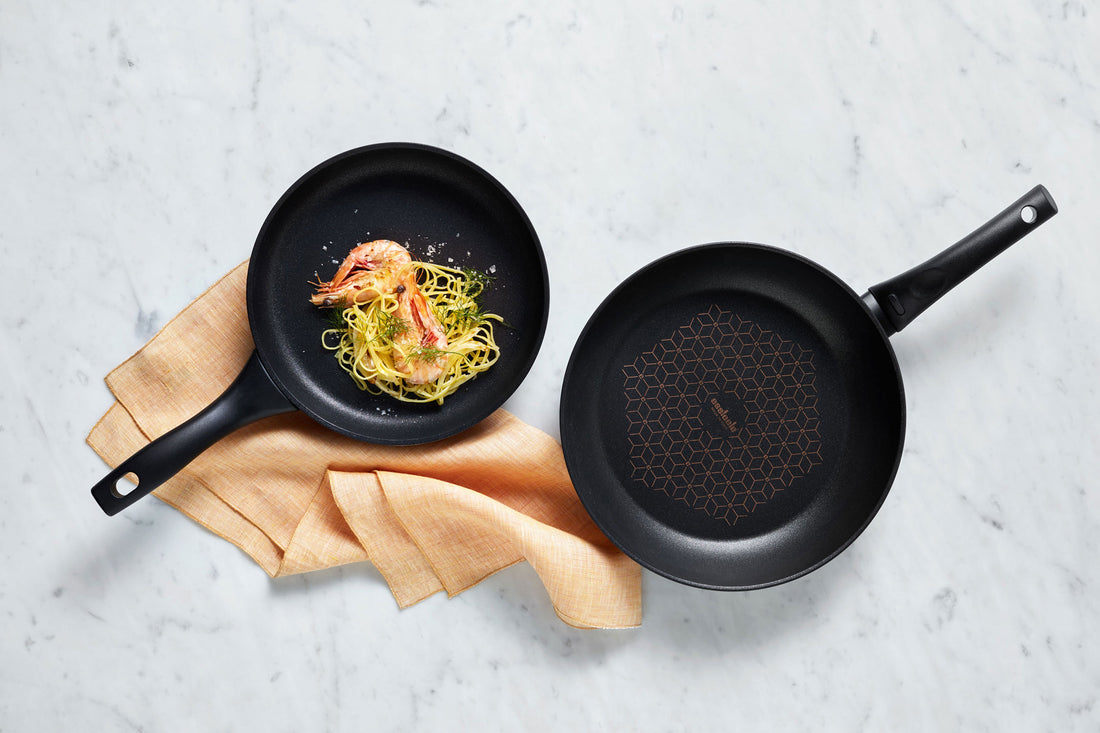Whether you’re preparing a curry for dinner or whipping up your Sunday breakfast, chances are you’ll be using a frypan. Also known as an open French skillet, or simply a skillet, a good frypan is an essential tool in any kitchen. One of the most versatile items of cookware, a frypan can be used for fast cooking, frying, searing and browning among a range of other things (frypan pizza, anyone?).
The home chef considering his or her options for cookware can be overwhelmed by the level of choice. It can be challenging to know which frypan is best suited to your needs without getting confused. Read on to discover what you need to consider before investing in your newest piece of cookware.
Size Matters
The first thing item on the agenda when purchasing a frypan is what size you should be looking for. Frypans generally range from 20cm up to 32cm in diameter. While 24cm is the most commonly purchased option, each option offers advantages based on your needs. As a general guide:
- 20cm frypans are ideal for serving 1 to 2 people and work best on small gas hobs. They allow for excellent heat control, are easy to clean, take up little storage space and are perfect for frying up small portions of vegetables (vegetarians ahoy!). Due to their size, they’re not the best choice for cooking more substantial ingredients, so if you’re big on steak for dinner, this size isn’t for you.
- 24cm to 26cm frypans are the reliable all-rounders of the cookware world. Serving 2 to 3 people, they’re fantastic for everything from frying eggs and vegetables through to larger proteins like steaks, fish, chicken fillets and lamb chops. Convenient and easy to clean, these make for the perfect addition to your cookware collection.
- 26cm to 28cm frypans are the most versatile of the bunch as they can serve anywhere from 1 to 4 people. They can easily be used for whipping up a big batch of curry or pasta sauce and work well on both medium and large hobs. However, they may be slightly unwieldy for those with smaller hands due to their size.
- Finally, if you’re feeding an army of ravenous humans, 30cm to 32cm frypans are the way to go. They can be used for frying up family-sized portions as well as whole fish, T-bone steaks and pork chops. They only work on large hobs, and once again, their bulky size means that they may be challenging to manoeuver for some people.

Material World
Now that you know which size will work best for your household, it’s time to consider the material of your new frypan. There are three main options available: non-stick coating, stainless steel and hard anodised aluminium.
Nonstick
If you’ve ever scrubbed tirelessly at a skillet after cooking to get rid of grease, a nonstick pan will make you breathe a sigh of relief as food residue washes right off its surface. Suitable for cooking on low and medium heat, nonstick pans also require less oil than other varieties, which is a big selling point for the health-conscious consumer. Nylon and wooden utensils are better suited for use with non-stick pans, as their surface can be delicate and prone to scratching.
Stainless steel
As well as its classic contemporary look, stainless steel cookware performs well due to its superior heat conduction. Highly durable and long-lasting, stainless steel pans do an excellent job at producing deliciously browned food and searing meat at high temperatures. While it’s true that they require somewhat more upkeep than other types of cookware to ensure they continue to perform optimally, but if you’re okay with giving your frypan a good scrub after cooking, then you can expect it to last you well over a decade.
Hard anodised aluminium
Made from electrochemically treated aluminium, the surfaces of hard anodised aluminium frypans are twice as rigid as stainless steel and stick-resistant. They heat up evenly and quickly and are the pan of choice for many professional chefs and cooking enthusiasts. Because of their durability, you can use metal utensils without worrying about scratching or chipping the surface of your pan. They’re also incredibly easy to clean and dishwasher safe.
Handle
While often overlooked, the handle of a frypan is one of its most crucial components. Once you’ve decided on the size and material of your frypan, make sure to take note of the handle on the products you’ve shortlisted. Look for a handle that’s strong and will remain cool when cooking on a stovetop. Wider handles are more beneficial for cooking since they allow for better control, especially when you’re preparing food that needs to be tossed. Lastly, stainless steel handles are ideal for low heat conductivity since they can tolerate higher temperatures than plastic or silicone handles.
If you keep all this information in mind when purchasing your new frypan, you’ll be sure to settle on an option that will make cooking easy and convenient for years to come. Happy shopping, and bon appétit!

